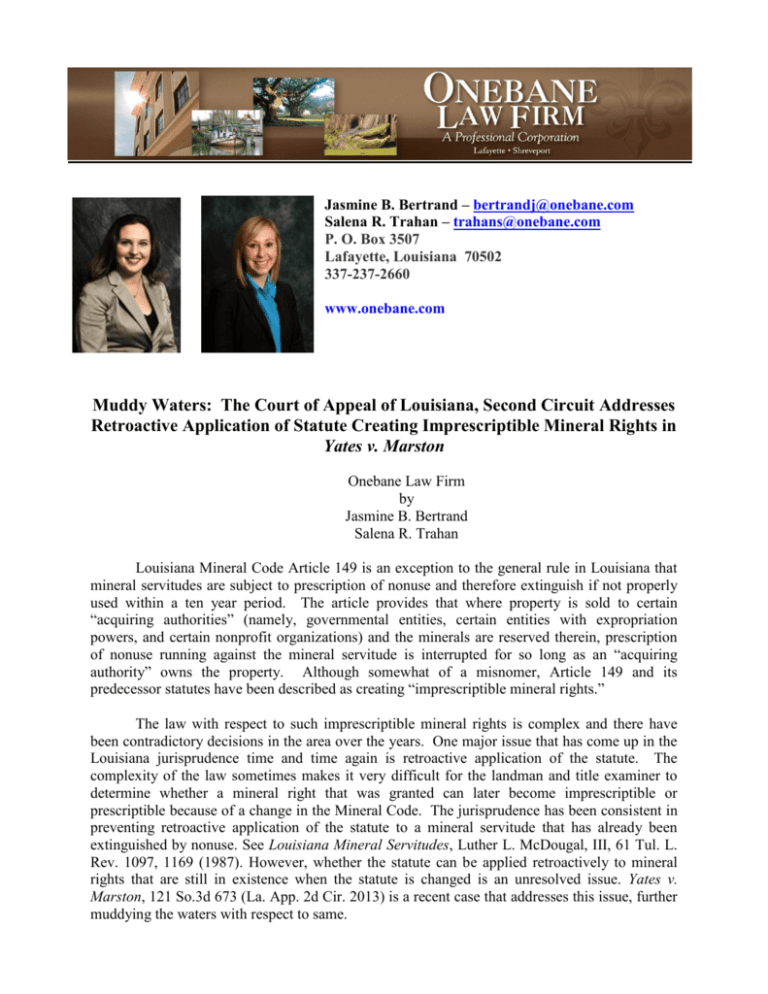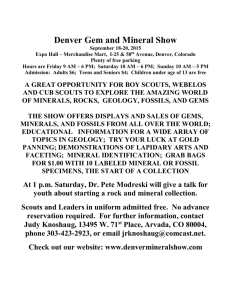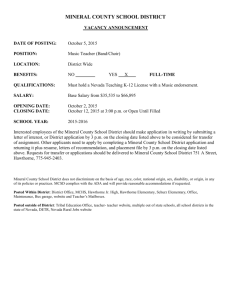
Jasmine B. Bertrand – bertrandj@onebane.com
Salena R. Trahan – trahans@onebane.com
P. O. Box 3507
Lafayette, Louisiana 70502
337-237-2660
www.onebane.com
Muddy Waters: The Court of Appeal of Louisiana, Second Circuit Addresses
Retroactive Application of Statute Creating Imprescriptible Mineral Rights in
Yates v. Marston
Onebane Law Firm
by
Jasmine B. Bertrand
Salena R. Trahan
Louisiana Mineral Code Article 149 is an exception to the general rule in Louisiana that
mineral servitudes are subject to prescription of nonuse and therefore extinguish if not properly
used within a ten year period. The article provides that where property is sold to certain
“acquiring authorities” (namely, governmental entities, certain entities with expropriation
powers, and certain nonprofit organizations) and the minerals are reserved therein, prescription
of nonuse running against the mineral servitude is interrupted for so long as an “acquiring
authority” owns the property. Although somewhat of a misnomer, Article 149 and its
predecessor statutes have been described as creating “imprescriptible mineral rights.”
The law with respect to such imprescriptible mineral rights is complex and there have
been contradictory decisions in the area over the years. One major issue that has come up in the
Louisiana jurisprudence time and time again is retroactive application of the statute. The
complexity of the law sometimes makes it very difficult for the landman and title examiner to
determine whether a mineral right that was granted can later become imprescriptible or
prescriptible because of a change in the Mineral Code. The jurisprudence has been consistent in
preventing retroactive application of the statute to a mineral servitude that has already been
extinguished by nonuse. See Louisiana Mineral Servitudes, Luther L. McDougal, III, 61 Tul. L.
Rev. 1097, 1169 (1987). However, whether the statute can be applied retroactively to mineral
rights that are still in existence when the statute is changed is an unresolved issue. Yates v.
Marston, 121 So.3d 673 (La. App. 2d Cir. 2013) is a recent case that addresses this issue, further
muddying the waters with respect to same.
In Yates v. Marston, the Second Circuit refused to retroactively apply Mineral Code
Article 149 and held that the prescription of nonuse did not apply to outstanding mineral rights
on land that was sold to a conservation organization. The 1,581 acre tract located in Red River
Parish which was the subject of the case had been owned by the Marston family for many years.
In 1995, the tract was sold to Rex and Sandra Young subject to a reservation of one-half of the
mineral rights. In 1997, Young sold the land to Ruby and Son Hui Yates and reserved one-half
of the executive rights and a one-fourth royalty.
In 2002, Yates sold the tract to the Nature Conservancy and reserved “in perpetuity
pursuant to and with the benefit of La. R.S. 31:149.1… all of the subsurface oil, gas and liquid
hydrocarbons in, on or under the property, including all executive rights and reversionary rights
related thereto.” A year later, the Nature Conservancy sold the tract to the United States. Up to
this point, there had been no operations on the tract or any unit pooled therewith. In 2008,
however, Yates executed a mineral lease, of which Petrohawk became assignee. Petrohawk
began Haynesville operations on the tract, creating and producing several units which included
portions of the tract. All bonuses and royalties were paid to Yates. In 2009, Yates filed suit
against Marston to quiet title to the mineral rights of the tract. Marston reconvened asserting his
claim to one-half the mineral rights reserved in the 1995 deed to Young. Later, Young
intervened asserting his claim to the executive and royalty rights reserved in the 1997 deed to
Yates.
A motion for partial summary judgment was filed by Marston and Young on the issue of
whether their mineral rights became imprescriptible by the sale of the tract to the Nature
Conservancy. At the time of the 2002 conveyance to the Nature Conservancy, former Mineral
Code Article 149.1 provided that when land was acquired from any person by a national,
nonprofit land conservation organization and made subject to a mineral reservation, prescription
of nonuse did not run against the servitude. The Article further provided that in the event the
conservation organization sold the land to the government, prescription of nonuse continued to
not apply. This statute was repealed in 2004, and simultaneously, the legislature amended
Mineral Code Article 149. The 2004 amendment provided that in the instance where land
subject to an outstanding, previously created mineral servitude is sold to a conservation
organization or other defined “acquiring authority,” prescription running against the outstanding
servitude continued to run and upon prescription of same, an “imprescriptible” mineral right in
favor of the transferor to the conservation organization was created. Marston and Young argued
that former Article 149.1 “created a special rule for conveyances to conservation organizations
whereby all outstanding mineral rights were made imprescriptible.” They also argued that the
2004 amendment, which repealed Art 149.1, could not be retroactively applied as it would divest
them of a substantive right. Alternatively, the argued that if the 2004 amendment made their
imprescriptible rights prescriptible, the running of ten years of nonuse was interrupted in 2008 by
Petrohawk’s operations.
In response, Yates contended that the imprescriptibility provided for under former Article
149.1 only applied to the person transferring the land to the conservation organization, not for
any outstanding mineral owners. Thus, the 2002 deed to the Nature Conservancy did not make
Marston and Young’s mineral rights imprescriptible. Furthermore, Yates argued that the current
Article 149 could be applied retroactively because it did not affect a substantive right. Finally,
Yates argued that amended Article 149 did not interrupt prescription but only suspended the
running of prescription until the statute was repealed in 2004. Thus, ten years of nonuse had run
from the creation of the prior mineral servitude and royalty interest in 1995 and 1997 before
Petrohawks operations in 2008. The district court granted the motion for partial summary
judgment finding that the mineral reservation in the 2002 deed made all mineral rights
imprescriptible. On appeal, the Second Circuit had two issues to resolve, specifically the
meaning of former Article 149.1 and the retroactivity of current Article 149.
The Second Circuit began its analysis by stating that former Article 149.1.A. as written
was ambiguous. The court reached this conclusion because former Article 149.1.A. referred to
“a mineral right”, using an indefinite article, but later referred to “the mineral right”, using a
definite article.1 Thus, the Court concluded that former Article 149.1.A. could be referring to
any outstanding mineral right at the time of acquisition by the conservation organization, not just
to the mineral right created at the time of the acquisition by the conservation organization.
The Second Circuit then looked at other articles in the Mineral Code, specifically Article
11 and Article 76, to find the purpose behind the statutes allowing for the creation of
“imprescriptible” mineral rights. In examining Article 11, which deals with the correlative rights
between the surface owner and the mineral owner, the Court found that Yates had to act with
reasonable regard to the rights of Marston and Young. While Yates conveyed to the tract to the
Nature Conservancy, the Court noted, Marston and Young “still owned significant mineral
interests in the land.” Therefore, the Court found that the reservation was “without reasonable
regard for Marston and Young’s rights.” Additionally, the Court looked to Article 76, which
states that “the expectancy of a landowner in the extinction of an outstanding mineral servitude
cannot be conveyed or reserved directly or indirectly,” to find that Yates could not reserve any
“reversionary rights” in the tract. The Second Circuit therefore found that Articles 11 and 76
supported the view that Article 149.1 A(1) exempted not only any mineral rights reserved by the
party conveying to the conservation organization, but any outstanding mineral right burdening
the land at the time of the sale to the conservation organization, from the running of prescription
of nonuse.
The Court also found that an examination of the legislative intent behind former Article
149.1 supported the proposition that the statute was enacted to protect outstanding mineral rights.
The Court noted that the Mineral Code, which took effect on January 1, 1975, replaced prior
statutes with Mineral Code Articles 149, 150, and 151 (all of which have currently been repealed
but were in effect at the time of the sale to the Nature Conservancy). Former Article 150
“expressly excluded ‘then outstanding mineral rights subject to … prescription’ from the special
rule of imprescriptibility.” In 1983, the legislature enacted Article 149.1, which extended the
exemption from prescription of nonuse to acquisitions made by conservation organizations. The
Court found that former Article 149.1 did not “replicate Art. 150’s reference to ‘then outstanding
mineral rights’ which would remain subject to the prescription of nonuse,” and that the omission
thereof shows a legislative intent to protect outstanding mineral rights in acquisitions by
conservation organizations.
1
The pertinent portion of the article reads as follows: A.(1) When land is acquired from any person by an
organization certified by the secretary of the Department of Natural Resources to be a state or national, nonprofit
land conservation organization by conventional deed, donation, or other contract and by the act of acquisition, a
mineral right otherwise subject to the prescription of nonuse is reserved, the prescription of nonuse shall not run
against the mineral right so long as title to the land remains with the state or nation, nonprofit land conservation
organization.
The Court then addressed the second issue in the case, being whether current Article 149
could be applied retroactively, and found that it could not. While Article 149 itself nor the
comments thereto state whether it may be applied retroactively, Article 214 of the Mineral Code
provides that “provisions of this Code shall apply to all mineral rights, including those existing
on the effective date hereof; but no provision may be applied to divest already vested rights or to
impair the obligations of contracts.” The Court cited Heirs of Viator v. Tri-Parish Investors2 to
conclude that Marston and Young’s rights were vested because they had the immediate absolute
right to produce minerals from the land. Further, the Court states “a change from the statutory
imprescriptibility of a mineral right to the standard ten year period of nonuse is a substantial
destruction, without due process of law, of their vested right.” Thereafter, the Second Circuit
referenced its own decision in Anadarko Production Company v. Caddo Parish School Board, et
al.3 and distinguished the facts at hand from Anadarko. In Anadarko, the Second Circuit did
apply La. R.S. 9:5806, which was enacted in 1958 and was the predecessor statute to Mineral
Code Article 149, retroactively to a 1954 sale.
There was a strong dissent in this by Caraway, taking issue with the majority’s judicial
interpretation of former Article 149.1. The dissent found that Article 149.1 was not ambiguous
and that the majority did not demonstrate how it was ambiguous by providing examples of how
the statute was susceptible to multiple meanings. Also, the dissent stated that the majority was
incorrect in finding that purpose behind Article 149.1 was to protect outstanding mineral rights.
The dissent contended that the purpose behind Article 149.1 was to provide imprescriptible
mineral rights when land is acquired by a conservation organization, not to make outstanding
mineral rights imprescriptible. Just because Article 150 was not amended, the dissent argues “it
is a leap in logic” to determine that therefore Article 149.1 makes outstanding mineral rights
imprescriptible. Additionally, the dissent noted that “the statute would certainly be unusual, if
not absurd, to turn on the whim of the landowner who sells the land to a conservation
organization and contemplates the measure of his benevolence to the owners of existing mineral
rights.” The dissent strongly suggested that not only did the majority misinterpret Article 149.1,
but it should have focused on the word “reservation” instead of the use of the terms “the” and
“a.” The legislation’s use of the word “reservation” means that something new is being created.
There is long line of jurisprudence regarding the “difference between the sale of a tract of land
with a reservation of the minerals and the sale of land subject to existing mineral rights in it. The
2
In Heirs of Avery Viator v. Tri-Parish Investors, Ltd., 618 So.2d 36 (La. App. 3d Cir. 1993), the Third Circuit held
that former Article 149 could not be retroactively applied when application would divest already vested rights.
In Viator, the plaintiffs owned land in Iberia Parish which the federal government acquired through expropriation in
1956, subject to a mineral reservation. In 1969, the federal government conveyed a portion of the property to a
private party. The court found that La. R.S. 9:5806, which was the statute in effect at the time regarding
imprescriptible mineral rights, was silent with respect to whether prescription applied if the land was returned to
private ownership. One of the arguments made in the case was that former Article 149, which provided that
prescription did so run if the land was returned to private ownership, should be applied retroactively. However, the
court found no retroactive application could be made to divest the plaintiffs of a vested right. The plaintiffs’ right to
the mineral servitude was imprescriptible and thus they had an absolute and immediate right to explore for and
produce the minerals.
3
In Anadarko Production Co. v. Caddo Parish School Board, 455 So.2d 699 (La. App. 2d Cir. 1984), the Second
Circuit applied La. R.S. 9:5806 (the predecessor to former Article 149) retroactively to a mineral servitude created
in 1954 when the land was sold to the Caddo Parish School Board. The court found that in this case, the mineral
reservation established a servitude of indefinite duration, which are governed by the general laws of prescription.
Since the ten year period of nonuse had not accrued when La. R.S. 9:5806 was enacted, a retroactive application of
La. R.S. 9:5806 would not affect vested rights or impair obligations of the contract. Thus, the prescriptible servitude
created in 1954 became imprescriptible by retroactive application of the statute.
former is accomplished with language of reservation and indicates that something new is being
created… but language of exception is necessary to declare the other.”
It should be noted that rehearing was granted in the Yates case. There appears to be,
therefore, a possibility that the approach of the dissenting opinion, which is a more logical,
common-sense interpretation of the law in this area and a better treatment of the facts at issue,
might have been the approach of the Second Circuit upon rehearing. However, before rehearing,
the case was dismissed by joint motion of the parties. Thus we are left with the Yates decision,
which contributes further confusion to the jurisprudence on the interpretation and retroactive
application of the law regarding imprescriptible mineral rights.
DISCLAIMER
The information contained herein presents general information about a legal issue and should not be considered legal advice. Before
acting on any of the materials presented here, we advise you to seek legal counsel. We welcome your calls, letters, and e-mail; however,
contacting us does not create an attorney-client relationship. Please refrain from sending any confidential information to us until such time as an
attorney-client relationship has been established.






